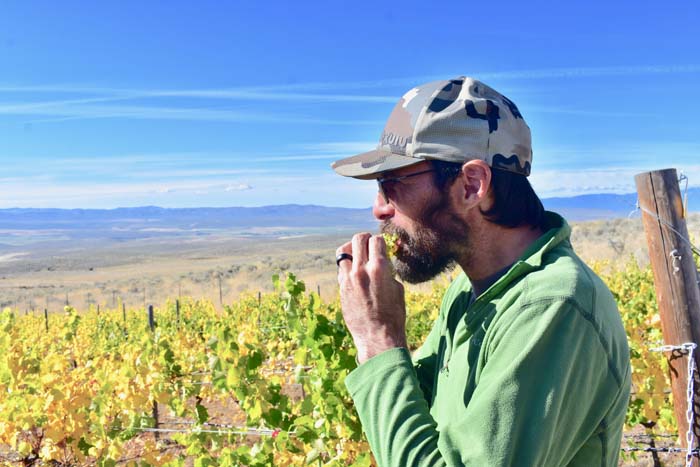Grabbing grapes
Published 10:00 am Friday, October 20, 2023

- Travis Cook samples a bunch of Riesling grapes during the harvest of the Copper Belt vineyard in Keating.
KEATING — Travis Cook maneuvers his tractor between the rows of grapevines, keeping an eye on the massive machine behind him.
Once he’s satisfied with the angle, he starts forward and the plants disappear inside the harvester, sending a shudder down the row as ripe grapes fall off the vine.
The fruit is destined for the winery and, eventually, a bottle of wine sold under the Copper Belt label.
Cook, who has been in vineyard and wine business for 18 years, has always relied on crews to handpick the grapes at his Keating vineyard, as well as vineyards that he manages in Richland.
But labor has been hard to recruit in the last few years.
For the 2022 harvest, he paid $37,000 for a harvest crew and still couldn’t get everything picked.
“Four acres still rotted on the vine,” he said. “I can’t afford to leave fruit on the vine.”
He manages and harvests grapes from three vineyards — three acres in Keating, and 20 acres in Richland. An operation his size, he said, wouldn’t typically consider buying a mechanical harvester.
But he didn’t want to lose fruit again.
He found a deal on a used Gregoire harvester, and estimates the investment will pay off in about three years.
Cook said it takes a crew of six to eight people about eight hours to pick one acre of grapes.
It takes the harvester about an hour and 15 minutes to pick the same area.
Cook controls the machine from his tractor. It operates by hydraulics, and can raise or lower to adjust to the terrain. As Cook pulls it down the row, rods inside oscillate to shake fruit from the vine and onto a conveyor belt. From there, the grapes fall into cups, which carry the fruit to the top and through a destemmer. The clean grapes then drop into bins located on each side of the harvester.
“All the processing is done by the machine,” Cook said. “It picks cleaner than hand harvesting, and it’s better, higher quality than I’ve every dealt with. This has been the least stressful harvest in over a decade.”
This is the 20th growing season for the Keating estate vineyard, which sits at 3,400 feet elevation on a hillside more prone to grow sagebrush than wine grapes. This land was settled by his great-grandfather over 100 years ago.
Grapes, Cook said, can grow for a long, long time.
“As long as disease doesn’t get them, and you take care of them,” he said. “Around the world there are vines hundreds of years old.”
As he takes a break from the harvest to sample a cluster of Riesling grapes, he looks to the west where the Elkhorn Mountains dominate the horizon on this mild October morning.
“The only other growing areas this beautiful are in Europe,” he said.
Of the seven varietals of grapes he grows, he can’t choose one he likes best.
“They’re all my favorite,” he said with a grin.
Once harvested, it takes 18 to 24 months before red wine is ready to sell. The time is shorter for white, at about six months.
He said the vineyards yield between two and three tons of fruit per acre, and he produces about 60 cases of wine per one ton of fruit. There are 12 bottles of wine in a case.
A family affair
Copper Belt is truly a family business. Joining Travis in the vineyard venture are his wife, Krista, and his parents, Michael and Cathy. The original vineyard is planted near the home of his grandpa, Elton.
To learn more about Copper Belt, visit the tasting room at 1937 Main St. in downtown Baker City, or check the website, copperbeltwinery.com.




